Você precisa de um plano em destaque para ter um site
O objetivo da arte é lavar a poeira da vida cotidiana de nossas almas
Pablo Picasso
Crie seu site independente instantaneamente
Crie seu site de arte profissional e conecte-se com seus colecionadores com temas personalizáveis, exposições virtuais e ferramentas poderosas
